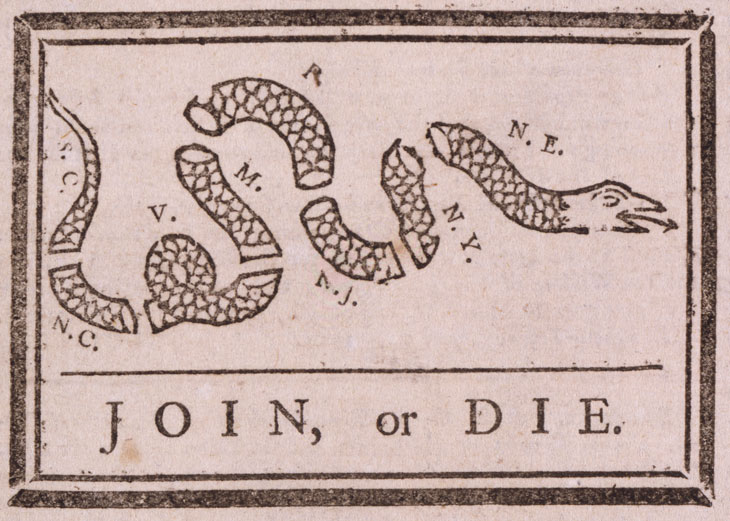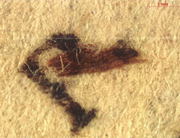|
eXplorations>The
Revolution>Teacher
Resources>Join or Die

Join or Die
Library of Congress
Illustrated in the Pennsylvania Gazette, May 9, 1754
Join or Die, the first political cartoon published in an American
newspaper, illustrates Benjamin Franklin's warning to the British
colonies in America "join
or die" and exhorting them to unite against the French and the
Natives. It shows a segmented snake, "S.C., N.C., V., M.,
P., N.J., N.Y., [and] N.E."
This cartoon appeared in Ben Franklin's newspaper, the Pennsylvania
Gazette on May 9, 1754
as part of an editorial
by Franklin
commenting on 'the present disunited state of the British Colonies.'
The woodcut drawing pictures a divided snake
in eight pieces representing as many colonial governments. The drawing
was based on the popular superstition that a snake that had been
cut in two would come to life if the pieces were joined before sunset.
The drawing immediately caught the public's fancy and was reproduced
in other newspapers.
It has been suggested that the Join or Die snake is
a
“cartographic
caricature,”
or
a map generalizing and exaggerating the American colonies’ most recognizable
features - namely their locations and coastlines. The colonies are
represented in geographic order, with the New England colonies at
the head of the snake and South Carolina at its tail. The
New England colonies are not listed individually and Georgia, oddly,
does not appear at all. The undulations of the snake’s body broadly
suggest the curves of the North American east coast.
Originally, it was thought that the letter above the fourth segment of the snake was an "R." Recently, however, it was determined that the letter is a "P," representing Pennsylvania. The Library of Congress inspected the original page containing the cartoon in their copy of the Pennsylvania Gazette that was published on May 9, 1754. By looking at the woodcut under a microscope, the conservators discovered that that, "What appears to be a diagonal leg of the letter R is actually embedded in the paper; it is what papermakers call an 'inclusion' or 'shive.' A shive is a piece of papermaking fiber that was present at the time the paper was produced" (Library of Congress letter dated March 30, 2017).
Detail from microscopic examination of
the Join or Die image
from the Library of Congress copy of
the Pennsylvania Gazette, May 9, 1754. |
 |
(Cited from:
Colonial Willimasburg Primary Source of the Month, November 06,
http://www.history.org/history/teaching/enewsletter/volume5/november06/primsource.cfm)
|
